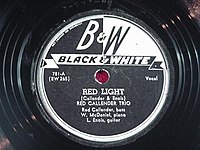Red Callender

George Sylvester "Red" Callender (born March 8, 1916 in Haynesville , Virginia , † March 8, 1992 in Saugus , California ) was an American jazz bassist ( double bass and tuba ).
Live and act
Callender went to school in New Jersey and took a touring job in a band when he was 17. Then he settled on the west coast. There he played with Buck Clayton (1936), Louis Armstrong (1937/1938), Lester Young (from 1941 to 1943, partly also with Nat King Cole ), his own trio (from 1944 to 1946) and Erroll Garner ( 1946/47). In 1946 he recorded with his trio of Willard McDaniel (p) and Leonard "Lucky" Enois (g) for Black & White Records ("Red Light"). In 1945/46 he worked on Lester Young's recordings for Aladdin ( The Complete Aladdin Recordings of Lester Young ). He starred in the film "New Orleans" alongside Armstrong (as well as in the film Jammin 'the Blues 1944, inter alia, alongside Lester Young and Sweets Edison ) and jammed with Charlie Parker , on whose dial sessions in February 1947 he starred. He then played with Johnny Otis and Cee Pee Johnson before he worked with his own band in Honolulu (1947–1950) and in San Francisco . After working for Red Norvo and Jerry Fielding until 1953 , he settled in Los Angeles , where he worked for NBC television. He has also produced records for small record companies.
In 1955 and 1956 he recorded his last record sessions with Art Tatum ( The Tatum Group Masterpieces Vol. 5 and Vol. 6 ). He performed at the Monterey Jazz Festival from 1962 to 1964 . As a sought-after session musician, he has appeared on Frank Sinatra and Ry Cooder albums . Callender became the most sought-after tuba player in Hollywood : He used this instrument with Stan Kenton (1965), Thelonious Monk , Charles Mingus ( Mingus at Monterey , 1964), James Newton (early 1980s) and Stevie Wonder . The Callender, who was influenced by Jimmy Blanton in timing and melody, played an accentuated pizzicato . Callender's playing had a lasting influence on his student and friend Charles Mingus on the double bass.
Web links
| personal data | |
|---|---|
| SURNAME | Callender, Red |
| ALTERNATIVE NAMES | Callender, George Sylvester |
| BRIEF DESCRIPTION | American jazz musician |
| DATE OF BIRTH | March 8, 1916 |
| PLACE OF BIRTH | Haynesville , Virginia |
| DATE OF DEATH | March 8, 1992 |
| Place of death | Saugus , California |